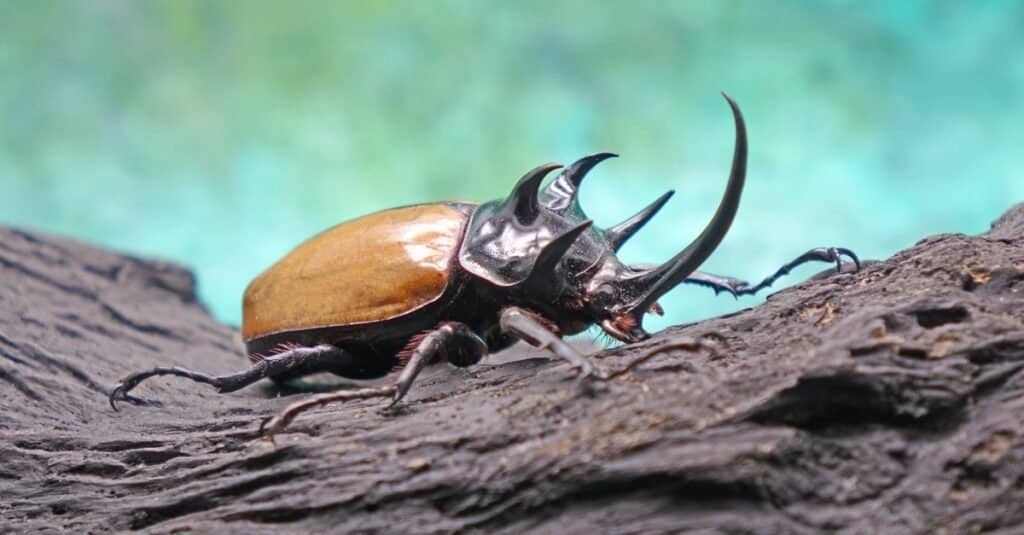Rhino Beetle
Rhinoceros beetles can lift objects 850 times their weight
Advertisement
Rhino Beetle Scientific Classification
Read our Complete Guide to Classification of Animals.
Rhino Beetle Conservation Status
Rhino Beetle Facts
- Group Behavior
- Solitary
- Fun Fact
- Rhinoceros beetles can lift objects 850 times their weight
- Biggest Threat
- humans
- Most Distinctive Feature
- Rhinoceros beetles have long horns on their heads.
- Distinctive Feature
- Rhinoceros beetles are massive in size
- Habitat
- under Leaf litter, plants, and fallen logs
- Predators
- ants, birds, rats, pigs, and some predaceous beetles.
- Diet
- Herbivore
- Lifestyle
- Nocturnal
- Favorite Food
- Plants of different species
- Type
- beetles
- Common Name
- Rhino beetle
- Special Features
- They have horns on their heads which look like the horns of a rhino
- Location
- Found worldwide except in Antartica
View all of the Rhino Beetle images!
Rhino beetles can lift objects 850 times their weight.
Summary
Rhinoceros beetles are a group of herbivorous insects known for the horn-like projections on the males’ heads that look like the horns of a rhino. Rhino beetles are also known for their enormous strength. Adults can lift objects to 850 times their body weight. Rhinoceros beetles grow really big and are among the largest beetles in the world. They are found on all continents in the world except Antarctica.
Rhino Beetle Species, Types, and Scientific Name
Rhinoceros beetles belong to a subfamily of scarab beetles known as Dynastinae. Beetles in this group are sometimes called Hercules beetles, a reference to their immense strength, or unicorn beetles because of the big horns on their head. There are over 1500 species of Rhinoceros beetles in 225 genera.
Rhinoceros beetles are scarab beetles (family Scarabaeidae). There are more than 30,000 species of scarab beetles found in various habitats all over the world. They are known for their stout bodies and clubbed antennae which they can use to sense odors in the air.
All rhinoceros beetles are known for their large size and unique shape. Some of the most notable members of this group include:
- Atlas beetles
- Common rhinoceros beetle
- Elephant beetle
- European rhinoceros beetle
- Hercules beetle
- Japanese rhinoceros beetle
- Ox beetle
- Eastern Hercules beetle
Appearance: How to Identify Rhino Beetles

The Five-horned rhinoceros beetle (Eupatorus graciliconis) known as Hercules beetles , Unicorn or Horn beetles , in tropical forest.
©Mark Brandon/Shutterstock.com
Members of the subfamily Dynastinae are among the largest beetles on earth. They are called rhinoceros beetles because of the curved horn-like structure on the heads of the males, which is their most distinct feature.
Like many scarab beetles, Adult rhino beetles have a convex back with a thick exoskeleton. Their thick outer wings or elytra cover membranous wings, which they use for flying. However, due to their massive size, they’re not very efficient flyers.
Their color often varies from black to a mottled greenish gray. Some species are also shiny with an almost metallic sheen. Rhinoceros beetles grow to massive sizes, which vary from one species to the other. Some species, like the Hercules beetle, can grow up to 18 cm (7 inches) long. The horn can make up as much as 10 cm (4 inches) of the total body length in this species. The elephant beetle is typically about 13 cm (5-inch) long, while the eastern Hercules beetle is about 6.2cm (2.4-inch). The American rhinoceros beetle is smaller, typically about 2.5 cm (1 inch) long.
The appearance and number of horns can also vary from one species to the other. For instance, while the Hercules beetle has a massive horn that looks like a pair of pincers, the elephant beetle has a long central horn that is split at the end. European rhinoceros beetles have backward-pointing horns. In all species, the beetles use their horns for territorial fights and mating rights. They also use their powerful horns for digging. The size of a rhinoceros beetle’s horn is an indicator of the physical health and nutrition of the beetle.
Habitat: Where to Find Rhino Beetles
Rhinoceros beetles live on every continent on earth except in Antarctica. They’re commonly found in forests, woodlands, parks, gardens, and hedgerows. Adult Rhinoceros beetles are more active during the summer months. They’re nocturnal insects. During the day, you will likely find them hiding under leaf litter, fallen logs, or dead tree trunks. Females lay eggs in old tree logs and stumps.
Diet: What Do Rhino Beetles Eat?
All species of rhinoceros beetles are herbivorous. Adults feed on leaves, fruits, nectar, and sap from various plants. The larvae of these beetles feed on decaying plant matter.
What Eats Rhinoceros Beetles?
The size of the rhinoceros beetle is their major defense against predators. They’re also nocturnal, which helps them avoid predators during the day. Their color blends well with the surrounding, serving as an efficient camouflage. Some species can also release a loud squeaky noise to evade predators. Despite these defenses, Rhinoceros beetles predators, such as ants, birds, rats, pigs, and some predaceous beetles, may attack rhino beetles. Many rhinoceros beetles also face threats from humans. People trade them as exotic pests, and deforestation due to human activities is destroying their habitat.
Prevention: How to Get Rid of Rhinoceros Beetles
Rhinoceros beetles are rarely considered pests because their population is usually not high enough to cause major damage. However, a few species, such as the coconut rhinoceros beetles, can infest plantations.
Rhino beetles typically prefer already sick or dying trees due to other factors. Thus, keeping your plants and trees healthy and properly cared for will prevent major damage. However, a few species can attack healthy trees and cause significant damage.
Given their massive size, you can easily pick out rhinoceros beetles and remove them. However, in cases of a large infestation, these beetles are often controlled using various forms of biological control. For example, the fungus Metarhizium anisopliae is a proven control agent to keep infestations down. In addition, pheromone traps are often used to lure and trap adults, and you can keep larvae populations down by chopping and burning decaying logs.
Related Animals
View all 114 animals that start with RRhino Beetle FAQs (Frequently Asked Questions)
Why is the rhino Beetle so strong?
Rhino beetles are known for their extraordinary strength. They’re quite long and are heavily built with powerful muscles. They also have long appendages with at least three legs touching the ground at all times, which gives them extraordinary balance and leverage. These factors allow them to lift objects several times their body weight.
Are rhinoceros beetles dangerous?
Despite their massive size and intimidating appearance, rhinoceros beetles are completely harmless to humans. They do not bite or sting. Their massive horns are mainly used for digging and fighting with other rhinoceros beetles for territory and mates.
Can you have a rhino beetle as a pet?
Yes, rhinoceros beetles are quite popular as pets, especially in Asia. This is because they’re relatively clean, safe to handle, and easy to maintain.
Do rhino beetles fly?
Yes, Although they’re lazy fliers, rhinoceros beetles can fly. They have a pair of thick outer wings or elytra which protects a pair of membranous wings underneath. Rhino beetles can open their outer wings to reveal the inner wings and fly.
What are the differences between rhinoceros beetles and dung beetles
The biggest differences between dung beetles and rhinoceros beetles can be found in their size and diet.
What are the differences between a stag beetle and a rhino beetle?
The differences between a stag and a rhino beetle can be found in their morphology and size.
Thank you for reading! Have some feedback for us? Contact the AZ Animals editorial team.
Sources
- The National Wildlife Federation, Available here: https://www.nwf.org/Educational-Resources/Wildlife-Guide/Invertebrates/Rhinoceros-Beetles
- Wikipedia, Available here: https://en.wikipedia.org/wiki/Dynastinae
- Encyclopaedia Britannica, Available here: https://www.britannica.com/animal/rhinoceros-beetle-insect-subfamily

















